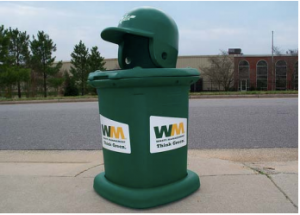As a massive source of public entertainment in the United States and around the world, professional and collegiate sports teams attract a tremendous amount of fans to their stadiums and arenas. In fact, the top 200 stadiums in the United States draw almost 181 million visitors per year. With this amount of people attending games and matches, the managers of these facilities hold a responsibility to manage the amounts of waste and environmental pollution created by fans both within the stadium or arena and outside its gates.[1]
Two main aspects of these sports venues that have room for improvement are stadium development and waste management. With the explosion of the popularity of sports, 66 new stadiums have been built for teams in the four major professional leagues (NFL, MLB, NBA, NHL) over the past two decades. Some of the problems associated with building new stadiums and arenas include not considering sustainability during development as well as not considering the surrounding area and transportation systems while picking a location for the new stadium or arena. To solve these issues, developers should strive for the U.S. Green Building Council’s Leadership in Energy and Environmental Design (LEED) certification.[1] This certification is available to buildings that are highly efficient, green, and cost-saving.2 Stadiums and arenas that are certified are more environmentally friendly and save the teams money by consuming about 25 percent less energy and 40 percent less water than another stadium or arena of comparable size. Additionally, developers should put more thought into placing the stadium or arena in an area that is compatible with the local transportation system. If developers build the stadium or arena in a more strategic location, less energy will be used to get to the stadium or arena, and less transportation wastes such as greenhouse gases will be emitted as fans travel to the game. This change will also most likely benefit the team and make more revenue because fans will be more willing to travel to the games if the stadium or arena is in a more convenient location making it easy to use public transportation systems.[1]

Stadiums and arenas produce tremendous amounts of waste both within and on the outsides of their walls. This waste can come from items brought into the stadium, items bought within the stadium, and tailgates. Managers must take into account all of the possible sources of waste and also be aware of the local waste disposal and recycling policies. To be more sustainable, managers should advertise for sustainability and waste management within the stadium by using techniques to target fans and influence them to join the movement towards more sustainability at the games. An example of an advertising technique that is effective in targeting fans is the use of “Fan Cans,” which are recycling containers with a design on top that represents the sport played in that specific stadium or arena. Currently, there are disposable materials used at concession stands in stadiums that are not easily recyclable, such as low-grade plastics and polystyrene. Stadium managers should work to form partnerships with companies more dedicated to selling recyclable materials to sell their food at concession stands. If stadiums and arenas can all make these changes towards more sustainable practices, the sports industry can thrive while influencing fans to live more sustainable lives and making less of a negative impact on the environment.[1]
Sources:
[1]https://www.wm.com/sustainability-services/documents/insights/Stadiums%20and%20Arenas%20Insight.pdf
2https://new.usgbc.org/leed
-Danni Vines